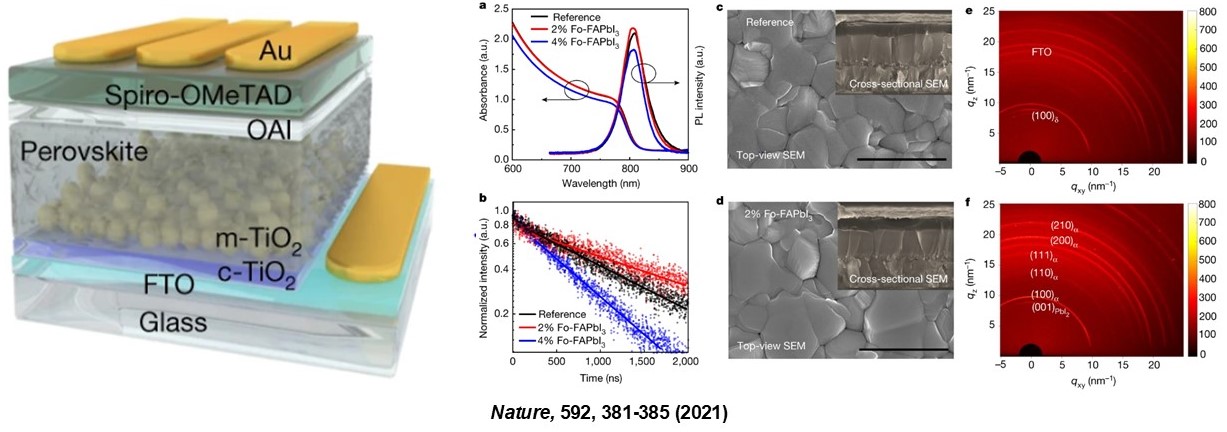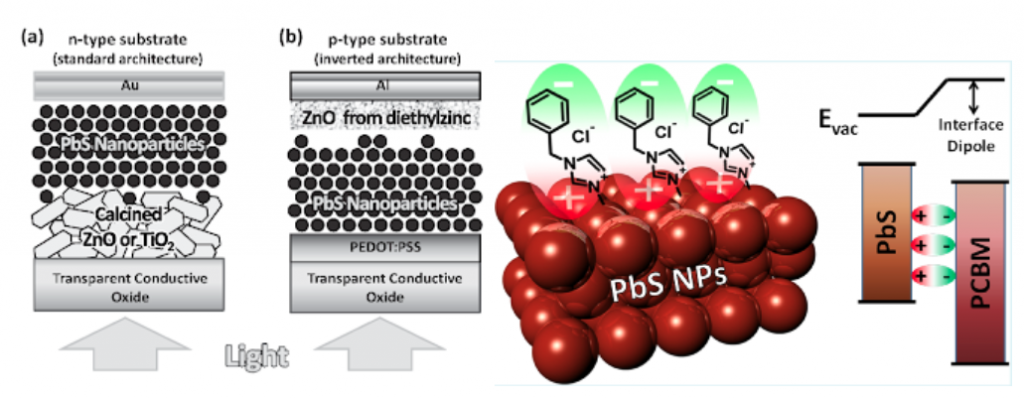Polymer Solar Cell


Polymer solar cells(PSCs) are one of the photovoltaic(PV) devices producing electric current from a layer that is a blend of donor and acceptor polymers by absorbing the sunlight. As one of new PV technology, PSCs have great potential because of their renewable, environmentally guaranteed, flexible, lightweight and inexpensive fabrication properties. They made from organic solvents using solution processing and have various device structure by changing type of donor and acceptor polymers, hole and electron transport layer or metal electrode. Recently, large-scale, transparent and flexible PSCs are investigated.
Perovskite Solar Cell


Perovskite Solar Cells(PVSCs) has great interests from many researchers because of PVSCs’ fascinated properties like high absorption coefficient and carrier mobility, long carrier diffusion length, tunable band gap and low exciton binding energy. The power conversion efficiency of PVSCs advanced from an initial 3.8% to a certified 25.2% by the solution processing. Recently, to study PVSCs’ high performance and stability, many researchers have tried to get better the quality of perovskite film and change the perovskite compositions and devices’ structures.
Perovskite Light Emitting Diodes

Perovskite Light Emitting Diodes(LEDs) which could be next generation LEDs material are better color purity than any kinds of LEDs. In addition, perovskite has excellent opto-electrical property. So we can make more efficient, vivid, simple, light weight, close to natural color of LEDs. Perovskite we use in electronic devices are halide perovskite ABX3 structure. Monovalent cation is used A site. For most of halide perovskite, leads are used for B site and halides are used for X site. Based on this, band gap is tuned by composition of A-site cation and X-site halide. So luminous colors are also tuned.
Water Splitting

Hydrogen is one of the solutions to climate change caused by global warming because it is renewable and clean energy. One of the ways to produce hydrogen gas is the photoelectrochemical grinding system, which decomposes water molecules through solar energy to produce hydrogen and oxygen. To develop this technique, research is being conducted using single solar cells with large band gaps or applying tandem solar cells.
Colloidal Quantum Dot Solar Cell

Central to the entire discipline of “Colloidal quantum dot solar cells” is the use of colloidal quantum dots (CQDs) as a principal light absorber in solar cells. CQDs exhibit a tunability of optical properties of inorganic materials altering their geometrical shape or the degree of spatial confinement, as well as the availability of solution-processing, a impactful manufacturing technique in solar cells, to inorganic materials. These properties can give rise to the expansion of applicable area, such as photodiodes, light-emitting devices and photovoltaic devices with a low manufacturing cost.
Organic Field-Effect Transistor (OFET)

Organic field-effect transistor(or organic thin-film transistor) is a field-effect transistor whose channel is made up with organic semiconductors. Conjugated polymers or small molecules are typically used as a channel materials in OFETs. Bottom gate top contact(BGTC) structure is commonly used device geometry which is composed of Si(n++)/SiO2/Active layer/Au(or Al), where Si(n++) as a gate, SiO2 as a gate dielectric and Au(or Al) as a source and drain electrodes. Although its low mobility (~10-1 cm2V-1s-1) compared with inorganic FETs, the main advantages of OFETs are low-cost fabrication process, light weight and their flexibility to make flexible devices.








